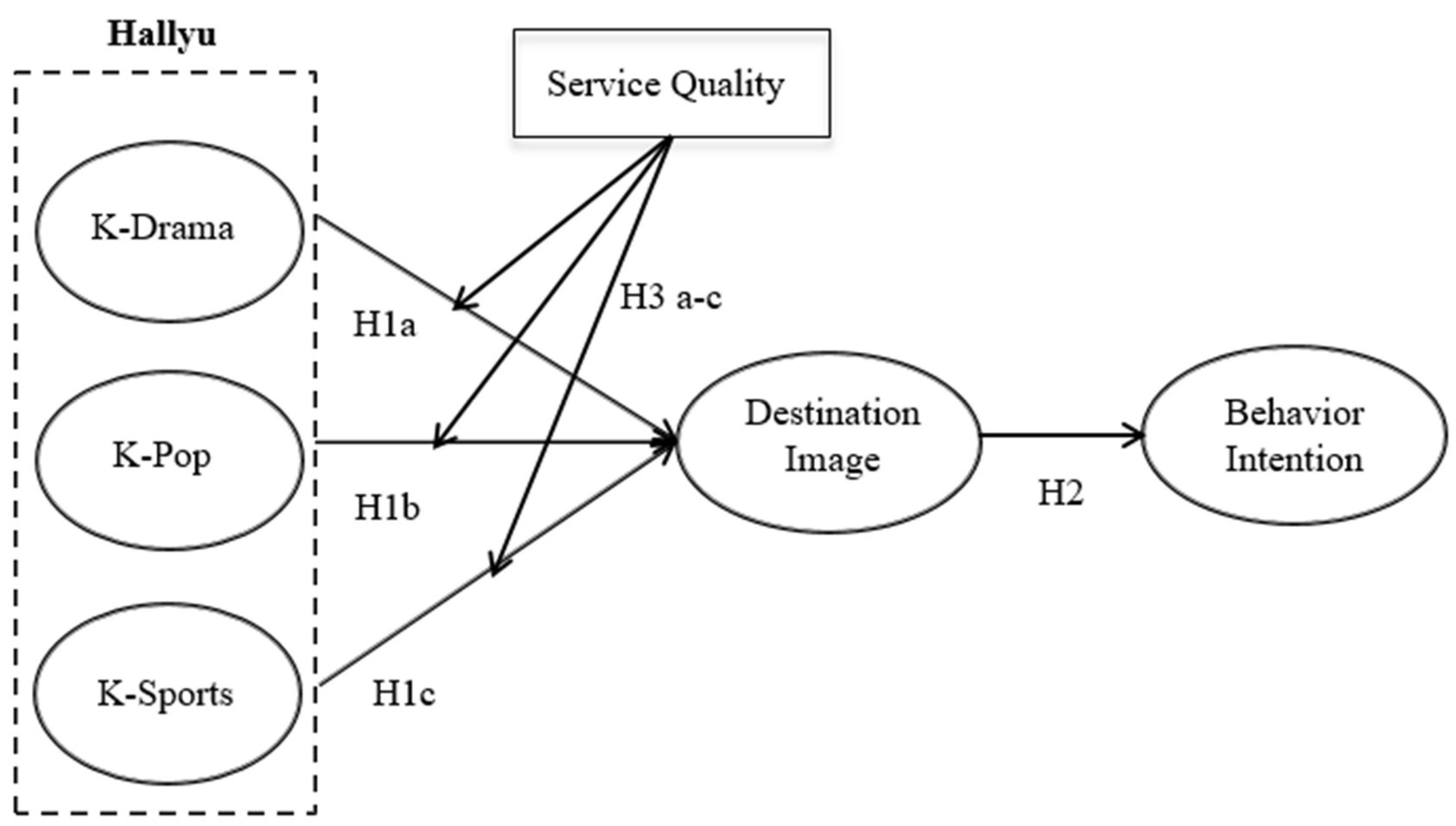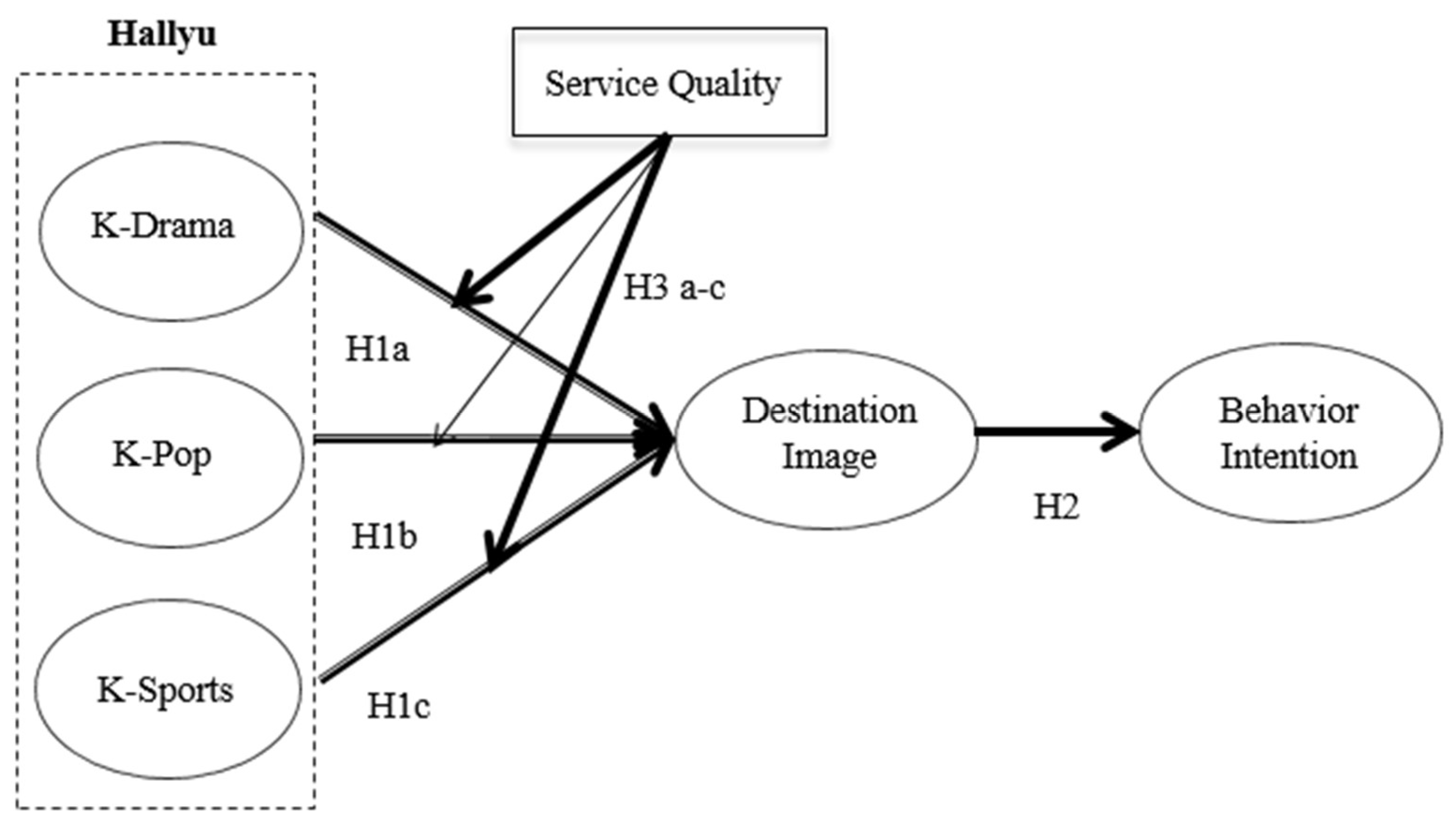The Influence of Hallyu on Africans’ Perceptions of Korea: The Moderating Role of Service Quality
Abstract
1. Introduction
2. Literature Review
2.1. Hallyu
2.2. The Relationship between Hallyu, Destination Image, and Behavioral Intention
2.3. The Moderating Role of Service Quality
3. Methods
3.1. Measurements
3.2. Data Collection
4. Results
4.1. Measurement Models
4.2. Structural Model: H1 and H2
4.3. Structural Model: H3
5. Discussion and Implications
5.1. Theoretical Implications
5.2. Practical Implications
6. Limitations and Future Research
7. Conclusions
Author Contributions
Funding
Conflicts of Interest
References
- Lim, S.; Giouvris, E. Tourist arrivals in Korea: Hallyu as a pull factor. Curr. Issues Tour. 2017, 23, 99–130. [Google Scholar] [CrossRef]
- Kim, S.; Nam, C. Hallyu Revisited: Challenges and Opportunities for the South Korean Tourism. Asia Pac. J. Tour. Res. 2015, 21, 1–17. [Google Scholar]
- Lee, S.; Lee, W.; Jeon, H.-Y. Tourists’ Psychological Connection to Pop Culture Tourism: A Perspective of Psychological Continuum Model. Tour. Rev. Int. 2017, 21, 31–47. [Google Scholar] [CrossRef]
- Chen, C.-Y. Influence of celebrity involvement on place attachment: Role of destination image in film tourism. Asia Pac. J. Tour. Res. 2017, 23, 1–14. [Google Scholar] [CrossRef]
- Kim, W.-H. Performance drivers in the casino industry of South Korea. Asian-Pacific Econ. Lit. 2018, 32, 126–134. [Google Scholar] [CrossRef]
- Kim, W.-H.; Kim, K.-S. Pro-Environmental Intentions among Food Festival Attendees: An Application of the Value-Belief-Norm Model. Sustainability 2018, 10, 3894. [Google Scholar] [CrossRef]
- Cha, H.; Kim, S. A Case Study on Korean Wave: Focused on K-POP Concert by Korean Idol Group in Paris; Springer: Heidelberg, Berlin, 2011; pp. 153–162. [Google Scholar]
- Forum, W.E. Africa’s New Free Trade Area is Promising, Yet Full of Hurdles. Available online: https://www.weforum.org/agenda/2019/09/africa-just-launched-the-world-s-largest-free-trade-area/ (accessed on 9 April 2020).
- Choi, K.; Meng, B.; Kim, S.-B. The influence of cultural familiarity on Tanzanian millennials’ perceptions of Korea: The mediating roles of involvement. Asia Pac. J. Tour. Res. 2018, 25, 64–75. [Google Scholar] [CrossRef]
- Fedorenko, O. Korean-Wave celebrities between global capital and regional nationalisms. Inter-Asia Cult. Stud. 2017, 18, 498–517. [Google Scholar] [CrossRef]
- Chung, S.; Cho, H. Fostering Parasocial Relationships with Celebrities on Social Media: Implications for Celebrity Endorsement. Psychol. Mark. 2017, 34, 481–495. [Google Scholar] [CrossRef]
- Han, H.; Lee, J. A Study on the KBS TV Drama Winter Sonata and its Impact on Korea’s Hallyu Tourism Development. J. Travel Tour. Mark. 2008, 24, 115–126. [Google Scholar] [CrossRef]
- Chen, S. Cultural technology: A framework for marketing cultural exports—Analysis of Hallyu (the Korean wave). Int. Mark. Rev. 2016, 33, 25–50. [Google Scholar] [CrossRef]
- Hogarth, H.-K.K. The Korean Wave: An Asian Reaction to Western-Dominated Globalization. Perspect. Glob. Dev. Technol. 2013, 12, 135–151. [Google Scholar] [CrossRef]
- Touhami, B.; Al-Haq, F.A.A. The Influence of the Korean Wave on the Language of International Fans: Case Study of Algerian Fans. Sino-US Engl. Teach. 2017, 14, 598–626. [Google Scholar]
- Ko, E.; Chun, E.; Lee, S. Korean Beauty in a Global Cultural Context*. J. Glob. Fash. Mark. 2011, 2, 200–212. [Google Scholar] [CrossRef]
- Malik, S.I. The Korean Wave (Hallyu) and Its Cultural Translation by Fans in Qatar. 2019. Available online: https://www.semanticscholar.org/paper/The-Korean-Wave-(Hallyu)-and-Its-Cultural-by-Fans-Malik/40fc8c8fb600a74fea0b4f71c6cea9d5ef15252b (accessed on 9 April 2020).
- Kim, W.-H.; Malek, K. Effects of self-congruity and destination image on destination loyalty: The role of cultural differences. Anatolia 2016, 28, 1–13. [Google Scholar] [CrossRef]
- Kim, W.; Malek, K.; Kim, N.; Kim, S.J. Destination Personality, Destination Image, and Intent to Recommend: The Role of Gender, Age, Cultural Background, and Prior Experiences. Sustainability 2018, 10, 87. [Google Scholar] [CrossRef]
- Yoon, K.; Jin, D.Y. The Korean Wave Phenomenon in Asian Diasporas in Canada. J. Intercult. Stud. 2016, 37, 69–83. [Google Scholar] [CrossRef]
- Kim, S.; Kim, S.; Han, H. Effects of TV drama celebrities on national image and behavioral intention. Asia Pac. J. Tour. Res. 2018, 24, 233–249. [Google Scholar] [CrossRef]
- Akroush, M.N.; Jraisat, L.; Kurdieh, D.J.; Al-Faouri, R.N.; Qatu, L.T. Tourism service quality and destination loyalty—The mediating role of destination image from international tourists’ perspectives. Tour. Rev. 2016, 71, 18–44. [Google Scholar] [CrossRef]
- Armstrong, R.W.; Mok, C.; Go, F.M.; Chan, A. The importance of cross-cultural expectations in the measurement of service quality perceptions in the hotel industry. Int. J. Hosp. Manag. 1997, 16, 181–190. [Google Scholar] [CrossRef]
- Choi, T.; Chu, R.K.S. Consumer perceptions of the quality of services in three hotel categories in Hong Kong. J. Vacat. Mark. 1999, 5, 176–189. [Google Scholar] [CrossRef]
- Chen, C.-F.; Tsai, D. How destination image and evaluative factors affect behavioral intentions? Tour. Manag. 2007, 28, 1115–1122. [Google Scholar] [CrossRef]
- Oliver, R.L. Whence Consumer Loyalty? J. Mark. 1999, 63, 33. [Google Scholar] [CrossRef]
- Byrne, B.M. Structural Equation Modeling With AMOS, EQS, and LISREL: Comparative Approaches to Testing for the Factorial Validity of a Measuring Instrument. Int. J. Test. 2001, 1, 55–86. [Google Scholar] [CrossRef]
- Anderson, J.; Gerbing, D. Structural equation modeling in practice: A review and recommend two-step approach. Psychol. Bull. 1988, 103, 411–423. [Google Scholar] [CrossRef]


| Characteristics | Frequency | % |
|---|---|---|
| Gender | ||
| Male | 159 | 71.3 % |
| Female | 64 | 28.7 % |
| Age | ||
| Under 21 | 1 | 0.4% |
| 21 to 29 | 79 | 35.4 % |
| 30 to 39 | 120 | 53.8 % |
| 40 to 49 | 23 | 10.3 % |
| Education Level | ||
| College degree | 14 | 6.3 % |
| University degree | 63 | 28.2 % |
| Graduate degree | 146 | 65.4 % |
| How many years have you lived in Korea | ||
| Under 1 year | 49 | 22.0 % |
| 1–2 years | 87 | 39.0 % |
| 2–3 years | 21 | 9.4 % |
| 3–4 years | 29 | 13.0 % |
| Over 4 years | 37 | 16.6 % |
| Constructs and Items | Std. Factor Loadings a | Composite Reliability b | AVE c |
|---|---|---|---|
| K-Drama(KD) | 0.952 | 0.791 | |
| I am very interested in K-dramas. | 0.737 | ||
| I often watch K-dramas. | 0.753 | ||
| I think the storylines of K-dramas are unique. | 0.770 | ||
| I get immersed in the acting of K-dramas. | 0.631 | ||
| I recommend K-dramas to other people. | |||
| K-Pop (KP) | 0.826 | 0.652 | |
| I like K-pop lyrics and melodies. | 0.896 | ||
| I like the appearance of K-pop artists. | 0.743 | ||
| I often watch K-pop music videos. | 0.696 | ||
| I have purchased K-pop music. | 0.496 | ||
| I want to attend K-pop concerts. | |||
| K-Sports (KS) | 0.792 | 0.615 | |
| I often watch K-sports. | 0.782 | ||
| I am very interested in K-sports. | 0.737 | ||
| I recommend K-sports to other people. | 0.691 | ||
| Destination Image (DI) | 0.921 | 0.781 | |
| Korea is safe. | 0.925 | ||
| Korea has nice weather. | 0.911 | ||
| Korea’s environment is clean. | 0.901 | ||
| Korea’s sanitation level is high. | 0.899 | ||
| Korea’s historic heritage is interesting. | 0.878 | ||
| Korea’s cultural resources are interesting. | 0.871 | ||
| Korean people are friendly. | 0.855 | ||
| Korea’s nature is beautiful. | 0.822 | ||
| Service Quality (SQ) | |||
| The service I received while I traveled is worth the price I paid. | 0.901 | 0.931 | 0.799 |
| The service personnel provide the necessary information. | 0.897 | ||
| The service personnel offer high-quality service. | 0.893 | ||
| The service personnel have professional knowledge. | 0.891 | ||
| The service personnel offer fast service. | 0.887 | ||
| Behavioral Intentions (BI) | 0.911 | 0.732 | |
| I will continue to visit Korea. | 0.934 | ||
| I will say positive things about Korea to the people around me. | 0.931 | ||
| I will recommend visiting Korea to others. | 0.922 | ||
| I will prioritize visiting Korea when choosing a possible travel destination. | 0.911 |
| Paths | Standardized Estimate | t value | Results |
|---|---|---|---|
| H1a. KD → IM | 0.276 | 2.544 * | Accepted |
| H1b. KP → IM | 0.211 | 1.105 * | Accepted |
| H1c. KS → IM | 0.291 | 2.943 * | Accepted |
| H2. IM → BI | 0.418 | 5.890 * | Accepted |
© 2020 by the authors. Licensee MDPI, Basel, Switzerland. This article is an open access article distributed under the terms and conditions of the Creative Commons Attribution (CC BY) license (http://creativecommons.org/licenses/by/4.0/).
Share and Cite
Kim, W.-H.; Lee, C.; Kim, S. The Influence of Hallyu on Africans’ Perceptions of Korea: The Moderating Role of Service Quality. Sustainability 2020, 12, 3245. https://doi.org/10.3390/su12083245
Kim W-H, Lee C, Kim S. The Influence of Hallyu on Africans’ Perceptions of Korea: The Moderating Role of Service Quality. Sustainability. 2020; 12(8):3245. https://doi.org/10.3390/su12083245
Chicago/Turabian StyleKim, Woo-Hyuk, Chunghee Lee, and Sungsoo Kim. 2020. "The Influence of Hallyu on Africans’ Perceptions of Korea: The Moderating Role of Service Quality" Sustainability 12, no. 8: 3245. https://doi.org/10.3390/su12083245
APA StyleKim, W.-H., Lee, C., & Kim, S. (2020). The Influence of Hallyu on Africans’ Perceptions of Korea: The Moderating Role of Service Quality. Sustainability, 12(8), 3245. https://doi.org/10.3390/su12083245





